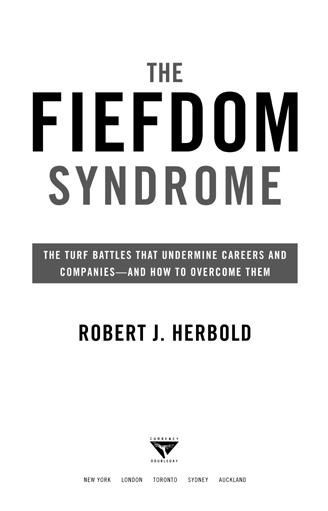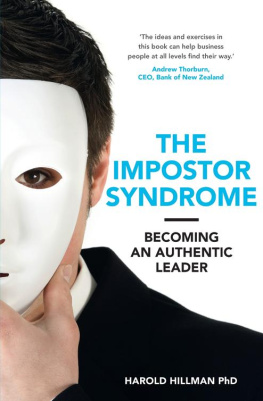

CONTENTS
This book is dedicated to my incredible wife, Pat, with whom I have shared almost forty years of marriage. I also want to acknowledge the support of our three children: Donna, Jim, and Greg. Throughout my almost four decades in business, I have had more than my share of fun, and none of that would have been possible without their ongoing encouragement and feedback as they listened to my stories and reacted to my experiences as they were happening.
The Fiefdom Syndrome is a must-read for any executive who faces the pervasive and crippling challenge of turf battles. All institutions need a clear, unified mission and Bob Herbold's new book will help managers achieve it.
HANK PAULSON, Chairman and CEO,
The Goldman Sachs Group, Inc.
The Fiefdom Syndrome tackles a pervasive and seldom-discussed problem, namely, why organizations tend to become slow-footed, fragmented, and mediocre. Herbold provides valuable insights into cutting through the fiefdom syndrome, allowing you and your team to make the most of your talents, improve your organization, and avoid stalled careers.
JOHN DOERR, partner,
Kleiner Perkins Caufield & Byers
Bob Herbold takes on the bureaucracy and turf battles that can undercut any company's agilitythe kinds of problems Sam Walton fought his whole life to overcome. I strongly recommend it.
ROB WALTON, Chairman of the Board,
Wal-Mart Stores, Inc.
I have seen many organizations with strategy or profitability problems where the core issues blocking their progress are the types of fiefdom-like behaviors Bob describes. The reader will highly value the powerful, useful learnings in this book, told via great war stories' by a very experienced practitioner. I strongly recommend The Fiefdom Syndrome.
ADRIAN SLYWOTZKY, author of the acclaimed books
Value Migration, The Profit Zone, and
The Art of Profitability
Fiefdoms, turf wars, and bureaucracy are often related to getting out of balance on centralization or decentralization. Bob Herbold provides valuable insights on how to achieve the proper balance and how to recognize and then avoid the pitfalls of decentralization that goes too far, i.e., fiefdoms.
DICK KOVACEVICH, Chairman and CEO,
Wells Fargo & Company
In this day and age, turf battles and bureaucracy are practically synonymous. As one who has seen these battles up close, both in the public sector and private sector, I was intrigued by The Fiefdom Syndrome. Bob not only analyzes the causes, he offers compelling suggestions on how to overcome them. Whether you are in business, government, education, or the nonprofits, I urge you to read this book, and, more importantly, to take its advice and put it to good use.
JACK KEMP, co-founder of Empower America and
former candidate for Vice President of the United States
The book has an important message for all organizations and individuals: there are some basic human behaviors that lead to performance-damping, career-crushing insularity and mediocrity. The Fiefdom Syndrome alerts you to the causes and the cures. This is a must-read for everyone, not just business people.
WALTER HEWLETT, independent software developer and
Chairman, The William & Flora Hewlett Foundation
INTRODUCTION
RECENTLY, ON AN airplane returning home to Seattle from a consulting job with a large corporation, I realized that, once again, I was seeing the same kind of problems in the company I was working with that I had seen many, many times before. Over the course of my thirty-six years in business, I have come to realize there is a set of behaviors that people exhibit that remind me very much of the feudal fiefdoms of the Middle Ages. Individuals and groups tend to isolate themselves from the larger organization, and worry more about defending their turf and protecting the status quo than in moving the organization forward. I call such behavior the Fiefdom Syndrome.
I've found this syndrome in nonprofit organizations, K-12 school systems, universities, and governments, as well as in private industry. The behaviors that characterize the Fiefdom Syndrome lead to a culture where ego and bureaucracy consistently trump common sense and innovation. They lead to turf wars. And they are almost always destructive.
It's not that people who exhibit Fiefdom tendencies are mischievous or unethical. These behaviors are simply natural human tendencies that emerge as people try to exercise control over their workplace environment, protect their domain, and avoid change that might upset the present order.
After retiring from the position of chief operating officer at Microsoft, where one of my chief tasks was to break through corporate fiefdoms and help to streamline the company, I decided to write down what I'd discovered about fiefdoms for general business readers. To a greater or lesser extent, fiefdoms have been a part of every organization I've ever encounteredand they can absolutely hamstring an organization's effectiveness, far more so, in fact, than any cyclical downturn or economic recession.
Turf wars can cause employees and managers to focus more on the size of their staff, the scope of their responsibilities, and their ability to manage their own affairs, than on the larger goals of the organization. The net result of such battles is that too many efforts are directed inward, instead of outward on the products and services the company is providing. We've all encountered such battles over turf, whether it's the department head who is a constant roadblock to efforts to change the way things are done, or the executive secretary or assistant who, in acting as gatekeeper, decides he or she is more important than the position justifies.
The observations in this book are the distillation of what I've learned through my many accumulated battle scars in the business world, as well as my involvement in nonprofits, schools and universities, and my interactions with government over the years. I've been fortunate to work with two world-class companies: Procter & Gamble for twenty-six years and Microsoft for nine years. Within those organizations I've seen a lot of the behaviors I decribe in this book. More important, I learned how these behaviors could be dealt with in an effective manner. My consulting activities with companies over the last three years have confirmed how prevalent these human behaviors are, and how detrimental they can be.
In some of the examples and anecdotes in the book, I name the organization and the people involved, to point out the problems and show how they were fixed. In many other examples, to avoid embarrassing the individuals or companies involved, I've disguised or altered their identities and changed the settings, while remaining true to the core experience and the insights to be gained into what the problems are and how to overcome them.
I believe that conquering the fiefdom syndrome is one of the most important things a company can do to improve its profitability. Being aware of the dangers of fiefdoms can be immensely valuable in shaping one's individual career, as well.
I would like to thank my administrative assistant, Kim McGee, whose incredible efforts were instrumental in helping to put my thoughts down on paper, and who was tireless in the revision process. Also, I am deeply grateful to Wes Neff of The Leigh Bureau, who encouraged me to tackle this project and contributed much to making it a reality. Last, but certainly not least, I want to thank Chuck Martin, who assisted in writing this book. Together we made a great team, and his experience really helped in creating an insightful manuscript. We also had a lot of fun doing it, because we were convinced that what we were doing was something that could
Next page








